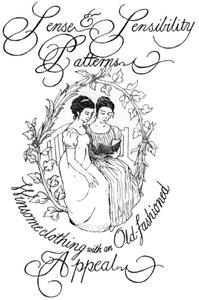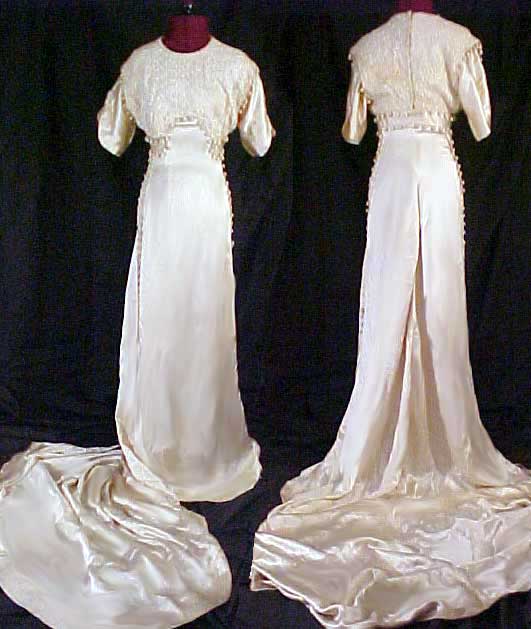ca. 1913 Wedding Gown
[gallery link="file" size="medium" ids="3688,11915,11914,11910,11911,11913,11912"]This stunning 1913 wedding gown was sold on eBay by USVainen, a seller (sadly, retired now) whose knowledge of vintage fashion was astounding and whose descriptions were delightful. This seller graciously agreed to let me share her images and words on my site, and I think you'll enjoy them as much as I did! Well worth the reading.
This dress is constructed of high grade silk with a luster similar to crepe de chine and features an intricate lace bodice with a stunning arched trim in the front and hand blown glass trim. The glass decorations are comprised of two parts: special glass pearl drops adorn the complete neckline and special opaque and white glass pearl agrafes (medallion) with hanging decorations of double-layered long clear glass globes on the dress' sides (globes are clear outer glass layer with a darker glass blown right into the inside). The agrafes were strategically placed above the sleeves and also at the sides of the dress near the bottom hem. They were placed so that when the wearer moved either her arm or leg, the double-layered glass globes would make a very delicate and beautiful "tinkling" noise similar to a windchime. It is obvious that the dress was specifically designed to entrance through a subtle assault on the most important senses: visual (silhouette cut with arched bust), auditory (glass agrafe chimes), and tactile (softest crepe de chine). The glass embellishments alone are worth the price of this dress - they have survived virtually intact and unbroken despite their delicate nature.The design of the dress owes quite a bit to the art nouveau movement in the United States. Horizontal and vertical lines were discarded in favor of arches, ovals, and curves. This gown was especially designed to take advantage of this movement with the careful placement of silk balls to highlight all of the curves. The top bodice shapes the lace into a beautiful arch and the side lace inserts are gently curved to give emphasis to the waist area of the woman. The inside of this dress has a muslin cotton "corset" that fastens separately.It could be said that true Edwardian fashion (best exemplified by the Gibson Girl's accentuated waist, hips, and behind) ended around 1909 - after which the great fashion machines such as Vogue were writing, "The fashionable figure is growing straighter and longer, less bust, less hips, more waist, and wonderfully long, slender suppleness about the limbs...... The leg has suddenly become fashionable!" By the end of 1912, nearly all American fashions had given in to the Paris fashion houses and the silhouette figure had bloomed - dress designs became completely vertical with no emphasis on the waist. Corsets expanded into long tubular items that ended well below the hips in order to accommodate these fashions. By 1915, dress hems would shorten to above the ankle and swell to nearly 3 yards in width - and then by 1916 dress hems would shrink back to the silhouette hobble style again until the early 1920s.1913 would be the last year that Paris dictated fashion until the 1920s. On June 28, 1914, while riding in a car in Sarajevo, the Archduke Franz Ferdinand of Austria-Hungary was assassinated by a Serb anarchist. This led to Austria-Hungary issuing an ultimatum to Serbia to which Serbia couldn't possibly comply. Austria subsequently declared war on Serbia on July 28, 1914. Due to a maze of European interlocking alliances, Serbia's ally Russia declared war on Austria and Austria's ally Germany declared war on both Sebia and Russia (France and England were also allies of Russia and Serbia and the Turks were allies of Austria and Germany - forcing them into the fracas as well). By mid-September, all of Europe was at war and Paris' fashion houses closed down and would not again dictate world dress until after the war ended with an armistice on November 18, 1918 (which is why Veterans Day in America is in November - it is actually "Armistice Day" in Europe and celebrates the events that ended World War I. Specifically, when a civil war in Germany caused the German Kaiser to flee to Holland and the Bolshevik Revolution in Russia ended the reign of the Czars, an amistice was declared and the war ended with the Treaty of Versailles). Paris fashion houses would not rebounded until the early 1920s - when famed French periodicals such as "La Vie Parisienne" would set the trend that the world's women followed.

